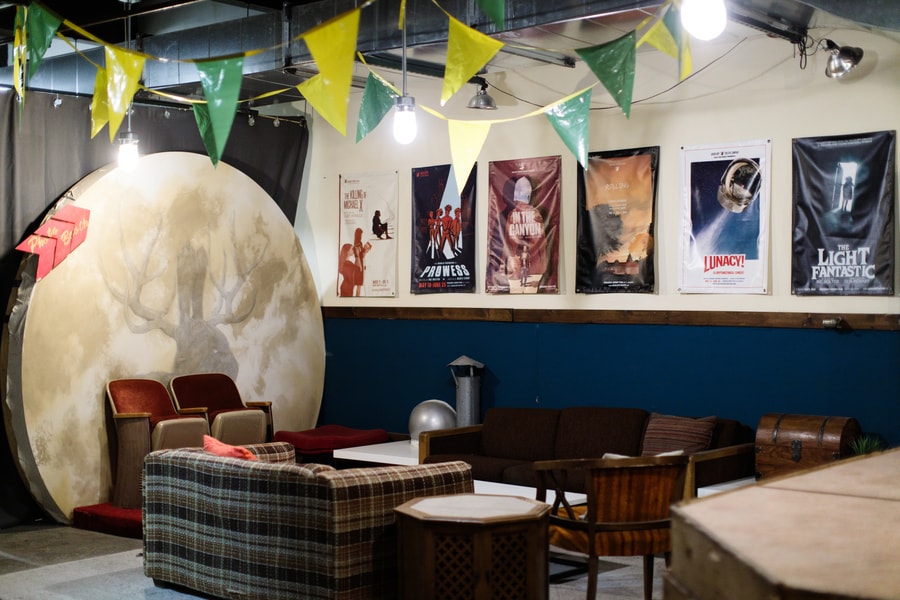When the pandemic hit Chicago theatres, it was uncertain, even to those most in the know, which would survive the shutdown. Chicago’s theatres, especially those that aren’t national name brands—the ones who have staked their claim among the 200-plus small to mid-sized theatres in the bustling, mostly non-union world of the storied Chicago storefront theatre scene—have always been resourceful. If you lose your performance space, you find another. If you’re short on money, a few chairs will do. But the pandemic was a huge new kind of challenge for theatres whose budgets can’t hope to match what the larger theatres in the city have.
“People were asking me in the beginning, how long can people hang on?” said Deb Clapp (she/her), executive director of the League of Chicago Theatres. “And I said, ‘We’re going to see some people [fold] in the next couple months, and then in six months—nobody can stay open for a year’” under lockdown. “That’s what I said: ‘Nobody, not Goodman, not nobody.’ I was wrong! And I’m glad I was wrong.”
Not that there weren’t some notable closures; but the larger bloodbath feared by Clapp did not—or at least has not yet—transpired. But among the small theatres that have eked out some kind of survival, the path has been far from clear. E.M. Davis (they/them), artistic director of Broken Nose Theatre, compared the past year to being handed a pandemic playbook, only to open it and realize the pages were blank. Over the past 14 months, Chicago theatre leaders like Davis have been writing the playbook themselves, navigating waters that have swept some away and left others wondering: What will be left of this once-vibrant scene when we all come back?
Many leaders I spoke with are still in a wait-and-see mode, even as larger theatres across the country seem to be gaining steam as they eagerly anticipate the vaccination of their artists and patrons and announce in-person performance dates as early as this summer. For Jackalope Theatre’s artistic director, Kaiser Ahmed (he/him), patience continues to be the signal virtue. Due to Jackalope’s partnership with the Chicago Parks District, by which the company has a performing venue at Broadway Armory Park, the company is at the mercy of the Parks District’s decisions on reopening.
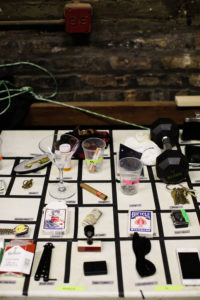
The building, Ahmed said, has been used as a spillover location for homeless shelters when private shelters in the city closed down. As Jackalope waits to return to their building, Ahmed’s company has focused on new-play development. When Ahmed made a trip to check on the space, he was greeted with the remnants of their last show still sitting there, collecting dust. He expects the dust to keep collecting for while: He said that Jackalope is looking at spring 2022 as the potential time of return to in-person performances at their space, by which time Ahmed expects the city’s theatre scene to have already returned to its bustling form.
“Most companies, especially in the storefront scene who are rental companies, who rent and produce in rental venues—I think they’re doing good,” said Ahmed. “They’re basically in hibernation, and when we’re ready to go again, they’ll be back into their seasons. I think that’s the resilience of the Chicago storefront scene.”
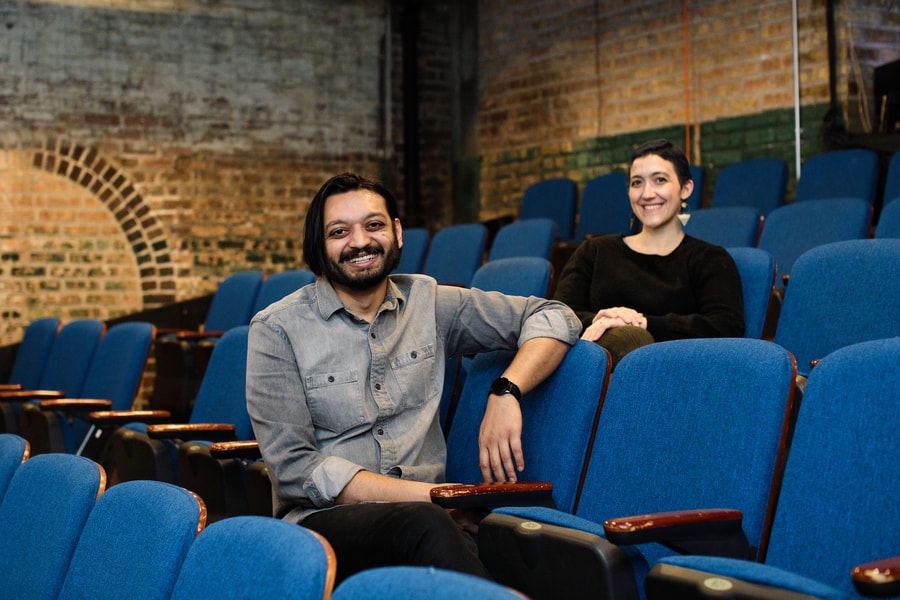
One such so-called “hibernating” theatre is Davis’s Broken Nose, a company that is also considering pushing in-person performances into the next calendar year. Broken Nose, which produces out of the rental space the Den, has spent the time away from in-person productions to focus on staged readings and to find ways to highlight ensemble and staff members as a way to reintroduce the company to audiences. Davis has taken the opportunity to work on the We See You, White American Theatre demands with their expanding ensemble, with the intention of being a more transparent company in general, including posting the company’s budgets for the last two seasons, during which time Davis was artistic leader.

“That’s a big thing that we’re trying to do,” Davis said, “in terms of additional transparency and genuine education on how theatre runs, especially at a storefront level. We’re still under six digits in terms of our yearly budget, so we’re at this really nice sweet spot of really showing how the numbers really affect us, especially coming from a pay-what-you-can theatre company.”
More transparency has included implementing an opt-in system that gives the ensemble and staff the chance to read the dozen or so plays up for season consideration and to provide feedback to leadership, and then go on to help leadership narrow production selections based on what inspires their ensemble before choosing which plays work best together dramaturgically. As they look toward their next season, Davis emphasized the need to not jump into things too quickly, because “literal lives are at risk if you trip.”
Davis, whose day job is in human resources, is especially concerned with questions around safety at a non-Equity theatre: Can their theatre require actors to be vaccinated? Would that violate rights around health and medical confidentiality? As a company renting a space where audiences and actors may be within touching distance at times, what are the safety requirements for audiences? How do you make sure actors feel safe? The Den itself has eight rentable theatre and event spaces ranging in capacity from 45 people to 275 people, which can mean a lot of bodies traversing the space on a performance night. And Davis is already mentally preparing for the mad dash for rental space once in-person productions resume.
“It’s going to be hard,” Davis admitted, “because we’re all going to be vying for attention again, and everybody has not had attention for the last year and a half. How do you continue to support while also supporting your own? I’m hoping everybody comes together.”
It’s a thought that has Davis wondering if one answer might be partnerships between small-to-mid-sized theatres that have their own space and rental companies like their own. One example they pointed to was Rivendell Theatre Ensemble, a formerly itinerant theatre company that moved into its own storefront space in 2011, which also houses Interrobang Theatre Project as a resident company. These partnerships could help offset some of the space closures that have been seen throughout the city.

In my conversations for this story, many relayed a similar thought: that smaller companies, where many of the key employees and artists have day jobs and the company has little or no overhead to be concerned with, have been able to sit idle, waiting to return. Clapp, Ahmed, and others voiced concern for what they see as the most vulneralbe: mid-sized theatres with spaces to maintain, but without the budget to handle the pandemic’s squeeze.
Some of the most notable moves have included Steep Theatre Company losing its long-time home after their building was sold and lease not extended; Prop Thtr closing its Avondale storefront after 15 years; Mercury Theater closing “permanently” last summer before announcing a return, and a new artistic director, last month. This past March, the Royal George, which mostly hosted commercial productions, was told to make alternative plans for productions, with their space likely to be sold for redevelopment. More recently still, Stage 773, a four-theatre space rental house and producing company that included resident theatre American Blues Theater, has announced plans to cease rental operations, pivoting to a new venture that executive director Jill Valentine believes will put many area artists to work while also adding a feather to Chicago’s artistic cap.
“As many of us have been empty and closed for the last year,” said Valentine, “it gave us a minute to kind of reflect on reopening and what that’s going to look like. There were many things that kept coming up as risk factors: When are renters going to want to come back? What are capacity issues going to look like? When are audiences ready to come back? You know, once those lights are on, those fixed costs, capacity or not, you’re paying the same.”
“We’re just trying to get really creative in how we begin to gently step into reopening, as opposed to thinking we’re going to reopen with this world-premiere play and be okay if 50 people see it through a six-week run.”
So Stage 773 began to envision a different way to get those artists to work, prioritizing being able to “get behind the wheel and drive the car” rather than continuing to wait and see how a post-pandemic rental scene would play out. The new vision, Valentine described, will involve completely renovating their 12,000 square feet to create an immersive experience that Stage 773 leadership hopes will become a national destination as well as a celebration of Chicago artists. The plan is to hire a variety of artists and designers, from sculptors to performers, to create something new and unique around their artistic visions. Valentine described it as a melding of museums, escape rooms, immersive theatre staple Sleep No More, and the artistic impulses of the participating artists.
While the specifics of this mysterious new space are still in flux, as the contributing artists will determine a lot of its shape, Valentine emphasized the desire for this to be something Chicagoans will feel proud of, and something that will get the city’s artists back to making art.
“There is nothing like this,” Valentine effused, “not only in the city, but I don’t even think nationally. There are immersive experiences, but then you put it inside a theatre and then you add art and a level of performance on top of it. It’s unlike anything.”
But while Stage 773 hopes to add a new wrinkle to the Chicago performance and art scene, the decision of the theatre to move away from rentals does limit options for others working in Chicago’s storied storefront scene, which many expect to be as vibrant as it was pre-pandemic, if not even more so, when it finally returns to full steam. But concern over overhead in the face of reduced capacity is one echoed by Rivendell’s artistic director Tara Mallen (she/her). With a theatre capacity that typically tops out around 50 people, operating at 25 percent capacity is not a realistic option (and a very stark image for those of us who have performed to houses of 15 or less in a Chicago storefront before).
Mallen said she had considered reopening in fall 2021, but didn’t want to get closer to that date only to have to reschedule it again. It’s perhaps a good impulse, with health experts recently saying that herd immunity is unlikely, though the specific fallout and effect on theatre of that is yet to be seen. Rivendell is instead among the chorus of theatres opting to wait until 2022, aiming to reopen in January with the world premiere of Spay, by Madison Fiedler, which previously had its opening scotched by the onset of the pandemic, and which will have a reading with Rivendell this June.
That patient plan, Mallen said, is in the interest of making sure the theatre can open at a capacity that makes sense for the theatre, and in a way where everyone involved can feel safe attending. Indeed, overhead concerns aside, this pause has turned out to be a welcome respite for a company that had just gone from being itinerant and project-to-project to running their own storefront space.
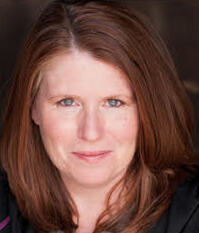
“We hadn’t had a pause since we opened that space,” Mallen said. “Suddenly we were running a small business and it was one show to the next. We were in there, we had rentals in there,” which meant that a lot of longterm tasks and maintenance “just kept getting pushed to the back burner.”
Mallen mentioned examples—lighting dimmers that needed fixing, flooring that needed replaceing due to a leak from an upstairs neighbor—of things that they’ve now found the time and space to fully address. The company has even taken this time to buy new seats for their theatre and to build new risers that allow their once fixed space to become completely flexible, offering more options for themselves and rental companies. In fact, Mallen said, in addition to anticipating the return of their resident company Interrobang, Rivendell has already been approached by multiple other companies inquiring about her space’s availability for the 2021-22 season.
“There will still be rentals,” said Mallen as she considered the changing rental scene in the city. “It just may take those of us that have spaces getting our spaces up and running and figuring out how many people you can have in. Then I think we’ll begin the business of being supportive of those itinerant companies.”
Rivendell has also used this pause in in-person productions to focus on virtual new-play development, work that has seen great responses from patrons, according to Mallen.
“We’re just trying to get really creative in how we begin to gently step into reopening,” Mallen said, “as opposed to thinking we’re going to reopen with this world-premiere play and be okay if 50 people see it through a six-week run. I’m also really trying to find ways to partner or collaborate with other organizations in the Chicago community.”
One example Mallen pointed to is an upcoming partnership with Pivot Arts for the 2021 Pivot Arts Festival: Reimagining Utopia. Participation in this summer’s festival will be what Mallen called “baby steps” toward in-person performances as they host dancer Laksha Dantran’s visualization of one trans woman’s nightmare during an isolating global pandemic. The theatre will host 10-15 people inside for a video presentation from the artists before returning outside to discuss the work. Rivendell is also actively looking for ways to support social service organizations in the city.

Partnerships with arts organizations is something Silk Road Rising co-executive artistic director Jamil Khoury (he/him) hopes will extend beyond the nonprofit sector as theatres look to repopulate storefronts. Khoury’s company, which he runs with his husband, Malik Gillani, itself has a bit of a non-traditional partnership, working with Chicago’s historic Chicago Temple to perform in an 85-seat flexible black box located on the lower level of the building. It’s a partnership—handed down from a senior pastor who was an early champion of their work to the current senior pastor—that has allowed the company to operate in a prime location in Chicago’s Loop.
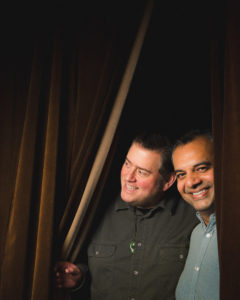
“We have been very lucky in that, early on, we landed a kind of institutional relationship with a church that said, ‘We view what you’re doing as part of our urban ministry,’” said Khoury, who noted that Silk Road itself doesn’t really use the word “ministry” to describe themselves. Still, he said, “I think that the connections between sacred space and theatre space are very vivid, very clear. We’re all in the business of telling stories with the hope of some sort of redemption, some kind of salvific goal.”
As Khoury looks toward the future of the city’s theatre scene, he anticipates the development of new and non-traditional theatre spaces. After all, Chicago’s storefront scene is what it is because of the ability of theatremakers to turn any space into a performance space, even (especially?) spaces that aren’t built to function as a theatre. As with others, he anticipates the demand for performance space will be high, and Khoury looks to the city as a potential answer to that call.
“I hope this becomes a city thing,” said Khoury, who is still looking to reopen in November or December of this year. “Landlords, people who own space, have to become partners in the cultural fabric of the city.”
The trouble is, there need to be incentives, guides, or provisions put in place by the city to encourage these moves. Khoury called it “terribly unfair” that nonprofits are asked to pay market rates, considering that the existence of theatres and art spaces are keys to a healthy, prosperous society. He also pointed to the unfortunate amount of closures that the city has seen in other sectors. What is happening to those spaces? Khoury wonders. Who is repurposing them, and what consideration is being given to cultural institutions? The answers to these questions seem elusive.
“We have this city of opportunity. I think it’s going to be another groundswell of talent that’s incoming, and this groundswell is going to be empowered.”
Unfortunately, a new arts initiative from the city of Chicago doesn’t seem promising for theatremakers looking for those answers. Arts 77, a citywide arts recovery and reopening plan announced on April 20 by the city and named after Chicago’s 77 neighborhoods, has set aside $60 million to fund artists and arts organizations throughout the city. Asked about the initiative, League of Chicago Theatres’ Clapp acknowledged that there were many wonderful aspects of the announcement, but she has seen nothing in it about recovery or general operating support for theatres. Clapp also pointed out that, with around 1,800 nonprofit arts and culture organizations in Chicago, $60 million isn’t nearly enough.
“I’m all for any investment in arts and culture,” Clapp said, before adding, “There’s nothing there for theatre. There’s a real need for actual recovery funds so that people can put up a show in their theatres.”
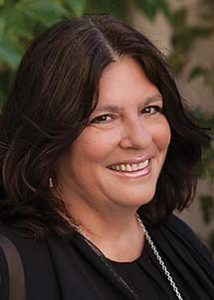
Clapp pointed out that many theatres, seeing the light at the end of the pandemic tunnel, are starting to look at hiring back staffs, upgrading safety features, and putting forward money to cover the costs of mounting a show—costs that build up far before ticket revenue can start flowing in the door. Historically, Clapp said, it’s been difficult to convince the city of Chicago to invest in these operating costs, so it still remains to be seen if a move like Arts 77 indicates any lasting change in the local government’s mindset around arts funding.
“If they were really to make a sustained investment in arts and culture across the city,” Clapp said, “that would be a big change. What I always really hope for is a sustained investment in the life of theatre in Chicago.”
In Clapp’s eyes, that life, at least in the near term, may be affected by which artists remain after the pandemic. Chicago is not alone among major cities that have seen artists move away to ride out the pandemic in places with lower costs of living. Rivendell’s Mallen thinks that a culling is bound to happen in response to this exodus, though Clapp thinks its impact will be less dire than that of a culture hub like New York, especially with many in the storefront scene reliant on day jobs rather than their theatre work for a regular income.
Whatever the near term future holds, Mallen said that in the slightly longer term she expects the storefront scene to rebound in its vibrancy.
“Chicago is not just supportive, but profoundly encouraging of people doing their own thing and making their own work,” said Mallen. “There is going to be a new class, a new cohort of young, energetic, gifted people coming to communities like Chicago and making their work work. They’re going to need spaces and they’re going to need storefronts, and they’re going to need support and mentorship from the organizations that have managed to soldier through it.”
Jackalope’s Ahmed echoed this thought, pointing to Chicago’s place within the theatre industry as something of an anomaly, noting that it’s “relatively cheap” to produce in the city, which he said opens the door for grassroots theatre efforts. He also noted that one of the city’s “biggest secrets” is how quickly Chicago’s talent can move through various sized houses around town.
“We have this city of opportunity,” Ahmed said, pointing to the city’s wealth of talent. “I think it’s going to be another groundswell of talent that’s incoming, and this groundswell is going to be empowered. You can raise just a few thousand dollars and make this happen. You can start a company and produce. I think that those conditions will still be there.”
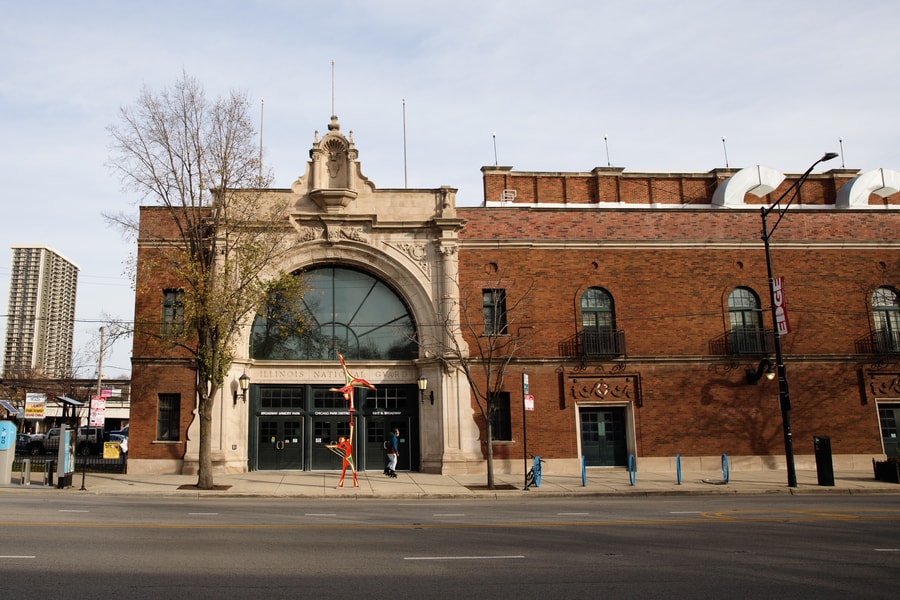
Importantly, Ahmed predicts that one big focus of that incoming groundswell will be to center community-focused and civically minded work. He believes that this time of pause and protest has given artists an opportunity to reflect and refocus their energy on theatre’s place within the larger community. At Silk Road, a company founded out of a response to the wave of anti-Muslim, anti-Arab, and anti-South Asian hate that followed Sept. 11, leaders Gillani, originally from Pakistan, and Khoury, whose father is from Syria, have watched as their initial drive to counter the scapegoating of 20 years ago has become painfully needed again in 2021.
“The sense of urgency really has not ended,” said Khoury. “The discourses around race, around ethnicity, around identity have just gotten, frankly, uglier and more violent. We as a sector understand innately that this is an empathic endeavor, and artists want to connect to audiences and audiences want to connect to artists. We have to dig deeper in terms of what connection means.”
Khoury emphasized the ability of artists and theatremakers to demonstrate what he calls “polyculturalism” for their audiences, centering diverse communities and the relationships between those communities in the work. And though, as Khoury said, there are still many people in this country who consider an America that doesn’t work for white supremacy as an America that doesn’t work at all, there is a dire need for the rest of the nation to stand for the America that is changing. Khoury is excited about the potential for a United States that finally, actually works for everyone.
“America is in such a weird place,” said Khoury. “We are more polarized than I can remember. I feel like artists are ready to transition this country to a much healthier and better place. Artists have to lead and help us all figure out a way out of this.”
At Broken Nose, this takes the form of becoming a more proactive company, mixing the celebration of the art with talking about the important issues in the community and world at large. As Davis explained, they are working on uplifting other nonprofits and the work of marginalized communities in their newsletters, noting that this is something that can be continually done and not simply a resource theatres provide in the wake of a tragedy.

Still, this uplifting of work is no substitute for funding, particularly for culturally specific theatres. Chicago’s Congo Square Theatre is celebrating 20 years as an organization that creates art by, for, and with Black artists. Charlique C. Rolle (she/her), who joined the company last August as its new executive director, said this period has been one of reinvigoration for the company. The turmoil faced by the community, city, and country has reinforced the critical need for organizations like Congo Square to be a home and advocate for a community that so often faces barriers when working with predominantly white institutions (PWI).
“It forces us to continue to push and fight that much harder for funding and support,” said Rolle, noting that PWIs regularly receive funding for diversity, equity, and inclusion (DEI) initiatives while organizations like hers receive far less support. “If we want to address DEI, put it in the place where the underrepresented people are able to get what they need. That’s one of the hardest things, a lot of our artists have been featured by other companies in their performances because they have received enough funding to pay them much more than we are able to.”
As Rolle looks to lead the company out of the pandemic, she also emphasized the role the company can play in creating a better pipeline for Black artists, showing them that there is a path other than the ones that typically lead students to the doorsteps of PWIs when looking to work in this industry.
“This is a place where you can be free,” said Rolle. “We hear the stories of some of our artists who have been at other institutions and not been able to really be free and who they are. We want to create a space where they can just freely be who they are.”
Rolle believes that Chicago’s theatre scene has been transformed by this pause, and that this transformation will result in an even more vibrant scene than before. She attributed this both to theatres finding new ways to create through digital mediums, meaning more experimentation and the merging of genres, and to the eagerness of artists to get back into theatres to return to what they do best.
It’s a sentiment shared by Khoury, who added that a new theatrical landscape in the city could see these smaller companies, ones usually formed out of friendship or affinity groups, rethinking what well-worn concepts like “community,” “ensemble,” and “company” truly mean in relation to the field’s pursuit of equity. Even at Silk Road, Khoury said they’re working to find ways to move away from the grind that is a season-based approach and toward a more project-based season that centers the impact of the work on audiences and artists alike.
The last year has been one of great pain and great change for the country and the industry. As Ahmed told me, we need to be together in order to heal. And that’s where theatre comes in. That is theatre’s job. Theatre is a perfectly positioned art form to respond and rebound in a profound way, to bring people together and, yes, have difficult conversations, but also give people the chance to see their own stories onstage—to feel seen and heard after such a long time when it has been easy to feel alone.
“Since the beginning, I’ve had this vision in my head of walking back into a lobby that’s filled with people on an opening night,” said Clapp. “It doesn’t matter to me what opening night it is, I just want to be there with the people and I want to have that communal experience that is theatre. That connection, not just to the people on stage, not just to the story, but to the people I’m sitting with. I really miss that.”
Jerald Raymond Pierce (he/him) is associate editor of American Theatre. jpierce@tcg.org

